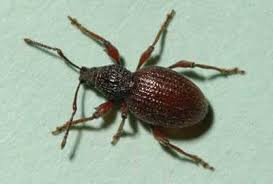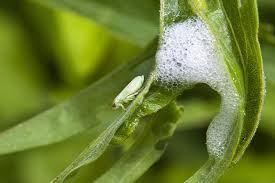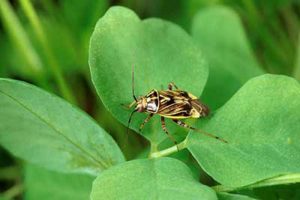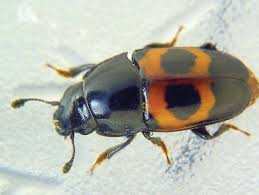Just like most fruit crops, strawberries are prone to pest infestation. In order for you to be able to produce a good crop, you may need to battle with certain pests posing threat to your precious crops. One of the most important things to consider in strawberry production is to identify the types of pests that could lead to production losses. Get to know the strawberry pests you need to steer clear of below:
- Strawberry Root Weevils

Strawberry root weevil
Some root weevil species damage and eat the young roots and crowns of strawberries. Adults will also feed on leaves but the greater damage is done as they tunnel in the roots and crowns of your crops. Once infested with strawberry root weevils, it will stunt the growth of your plants and will cause darkening of leaves that could weaken your precious crops or worse, it may lead to death.
As an adult, root weevils measure about 1/5 inch and are black to light brown in color. Some root weevil species will vary in color and size but in general, they are small, dark snout beetles having rows of pits on their back. You can tell that there’s an adult emergence when there are leaf notching in your crops. To avoid root weevils from spreading in new strawberry beds, you must plow under the old ones immediately.
- Meadow Spittlebug

Meadow Spittlebug
Meadow spittlebugs produce a white mass of wet foam or create spittle on the leaves, stems, and petioles of your plant. Just like the root weevils, they stunt the growth of your strawberry crops.
Spittlebugs are small, green insects producing spittle covering that protect them from predators. As nymphs, they will eat for about 5 to 8 weeks until they mature as adults. During their adult stage, they appear to be bright green and are commonly seen on foliage beginning late May and will start laying eggs in the leaves and stems of your strawberry crops starting July until October, having one generation each year.
Although spittlebugs may not cause significant production loss, they can stunt both the plant and the berries. Normally, these bugs thrive on weedy fields so it’s highly recommended to practice proper weed control.
- Tarnished Plant Bug

Tarnished Plant Bug
Feeding on the saps of your strawberry crops, the tarnished plant bug is another strawberry pest to watch out for. These pests will puncture through young fruits that result in a misshapen. If you’re lucky, there’ll only be slight deformation among your crops but it could also lead to a big production loss.
Adult tarnished plant bugs have greenish-brown bodies that have yellowish and black markings. Behind its head is a yellow-tipped triangle. The nymphs, on the other hand, are tiny and slender. Nymphs are normally pale green in color that looks like aphids. As the nymphs mature, they turn brown. The life cycle of a tarnished plant bug takes about 30-40 days to complete, having around 2 to 4 generations per year.
- Sap Beetles
The sap beetles are attracted to the plant’s sap usually from ripe fruits or damaged and cracked fruits. An indication that there’s a sap beetle infestation in your strawberry bed is when you see small holes in the bottom of the berries.
Sap beetles are small, flat, and oval that are normally black in color. One of the common sap beetle species is the picnic beetle, measuring about ¼ inch that has four yellowish spots on the covers of their black wings.

Sap beetle
To prevent attracting sap beetles, you need to keep your strawberry beds clean of ripe fruit as much as possible. If there are any damaged, cracked, or overripe fruits, remove it immediately. You can also use sap beetle traps in addition to proper sanitation.
- Slugs
Leaving off slimy trails on the surfaces of strawberries are the shell-less slugs. These yellow to black pests are about several inches long. They have no shell, thus, they need a moist area for them to live. Slugs commonly attack during rainy season and will most likely target strawberry fields having excessive mulch on its soil.
To prevent slugs from infesting your crops, keep your strawberry field clean and free from weeds and excessive mulch. If you can put trickle irrigation, it could be the best control method.
- Two-Spotted Spider Mite
Two-Spotted spider mites damage strawberry crops by piercing tissue using their mouthparts then sucking on the cell contents of your plant’s leaves. Signs of spider mite infestation are bronzing of the leaves and the undersides of the leaves have webbing. This could stunt the growth of your crops or could even result in death.
Having a light to dark green color, the two-spotted spider mites also have black spots on their abdomen. Female mites are able to lay around 200 eggs and the life cycle can be completed within 7 days, especially when the weather is hot and dry. Male mites appear to be smaller than females and have a more pointed abdomen.
If your strawberry field is already heavily infested with spider mites, you can use a miticide spray to get rid of these pesky pests. However, it is best to consult a pest control specialist to properly address your issue.

No Comments